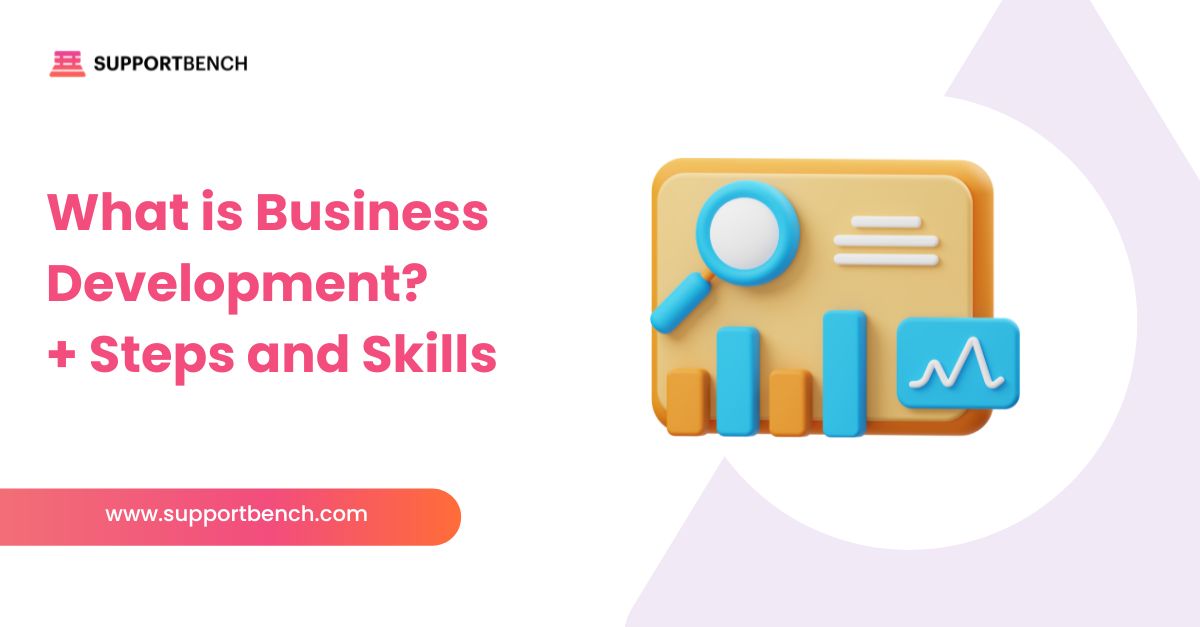Agent performance plays a central role in delivering quality customer service and building long-term loyalty. Without clear metrics, it’s difficult to know what’s working and where improvements are needed.
This guide covers the 20 most valuable agent performance metrics that support leaders should monitor. For each one, you’ll find what it means, how to calculate it, and how a platform like Supportbench helps track and act on these insights.
Let’s look at the numbers that shape better customer experiences.

Top 20 Agent Performance Metrics Every Support Team Should Track
Tracking agent performance shouldn’t rely on instinct. Reliable Key Performance Indicators (KPIs) help evaluate how well your support team meets customer expectations and contributes to business outcomes.
Focus on four essential performance areas: resolution speed, communication quality, customer satisfaction, and operational efficiency. Monitoring these consistently leads to smarter decisions, stronger teams, and better service.
1. First Call Resolution (FCR)
First-call resolution (FCR) measures how often customer issues are resolved during the first interaction, without the need for follow-up. A high FCR rate often correlates with happier customers and more efficient support processes.
Formula: FCR Rate = (Issues Resolved on First Contact ÷ Total First Contact Tickets) × 100
2. Average Handle Time (AHT)
Average Handle Time (AHT) refers to the average time an agent spends managing a customer interaction—from start to finish. This includes talk time, hold time, and any after-call work.
Shorter handle times often mean greater efficiency. But if they’re too short, it could indicate rushed or incomplete service.
Formula: AHT = (Talk Time + Hold Time + After-Call Work) ÷ Number of Calls Handled
3. Net Promoter Score (NPS)
Net Promoter Score (NPS) tracks customer loyalty by asking one key question: “How likely are you to recommend us to a friend or colleague?”
Respondents rate their likelihood on a scale from 0 to 10.
A strong NPS suggests a high level of customer trust, emotional connection, and satisfaction.
Formula: NPS = % of Promoters (9–10 scores) − % of Detractors (0–6 scores)

4. Customer Effort Score (CES)
Customer Effort Score (CES) gauges how easy it is for customers to get their issues resolved during a service interaction. Lower effort usually means better experiences and stronger loyalty.
Formula: CES = Average score from a survey asking, “How easy was it to resolve your issue?” (typically on a 5- or 7-point scale)
Supportbench makes CES easy to measure through built-in post-resolution surveys, helping identify friction points and improve the customer journey.
5. Customer Satisfaction Score (CSAT)
CSAT reflects how satisfied customers feel after a specific support interaction. It’s often gathered through short surveys sent after a ticket is resolved.
This score offers quick, actionable insight into daily performance and client happiness.
Formula: CSAT = (Number of Positive Responses ÷ Total Responses) × 100
Supportbench automates CSAT tracking and links satisfaction scores directly to agent performance, giving managers a clear view for coaching and improvement.
6. Average Response Time
Average Response Time measures how quickly agents send their first reply after a customer submits a support request. Fast responses are essential for reducing customer anxiety and improving satisfaction—especially for urgent issues.
Formula: Average Response Time = Total Time to First Responses ÷ Number of Tickets
Supportbench automatically tracks first-response times across all channels, helping teams spot delays and improve responsiveness.
7. Ticket Resolution Time
Ticket Resolution Time reflects the total time it takes to fully resolve a customer issue, from ticket creation to closure. Shorter resolution times typically point to efficient workflows and well-trained agents.
Formula: Resolution Time = Time Ticket Closed − Time Ticket Opened
This metric is especially useful for benchmarking team speed across various request types.

8. Number of Tickets Resolved
Number of Tickets Resolved tracks how many support tickets an agent or team resolves over a given period. This metric provides a clear snapshot of workload capacity and output.
Count the number of tickets marked as “Resolved” in your system for the selected timeframe.
Supportbench displays resolution counts on agent and team dashboards, making it easy to monitor progress and balance workloads.
9. Transfer Rate
Transfer Rate measures how often a customer ticket is passed from one agent to another before resolution. High transfer rates may signal training gaps or inefficient routing, leading to frustration on the customer’s end.
Formula: Transfer Rate = (Number of Transferred Tickets ÷ Total Number of Tickets) × 100
Supportbench logs and visualises transfer data so you can identify trends and fine-tune support workflows.
10. Escalation Rate
Escalation Rate tracks the share of tickets that must be escalated to a supervisor or specialist. While some escalations are expected, frequent ones can point to unclear processes or skill gaps.
Formula: Escalation Rate = (Number of Escalated Tickets ÷ Total Tickets) × 100
Supportbench flags escalation trends in real time, helping leaders target coaching efforts and revise escalation protocols when needed.
11. Adherence to Schedule
Adherence to Schedule measures how closely agents follow their assigned shifts, including start times, breaks, and logouts. High adherence ensures proper staffing during peak hours and supports a consistent customer experience.
Formula: Adherence Rate = (Actual Time Worked ÷ Scheduled Time) × 100
This metric is especially important in high-volume environments where minute-by-minute availability impacts service levels.
12. Contact Quality Score
Contact Quality Score evaluates the quality of agent interactions, typically through internal quality assurance (QA) reviews. It balances objective performance with subjective factors like tone, empathy, and adherence to protocol.
QA teams often use standardised scorecards to review a random sample of tickets, offering structured feedback agents can learn from.

13. Customer Retention After Support Interactions
Customer Retention Rate reflects how well agents contribute to long-term loyalty by examining customer behaviour after support is delivered. Do customers stay, renew, or buy again?
Formula: Retention Rate = (Number of Customers Retained ÷ Number of Customers Supported) × 100
Supportbench connects post-support actions to agent performance data, revealing patterns that can shape better retention strategies through smart analytics in customer service.
14. Average After-Call Work (ACW) Time
Average ACW Time measures how long agents spend on follow-up tasks after a call—like updating records, tagging tickets, or summarising the issue.
While necessary, extended after-call time can reduce agent availability. The goal is to streamline ACW without compromising quality.
Formula: ACW Time = Total After-Call Work Time ÷ Number of Calls Handled
15. Agent Utilisation Rate
Agent Utilisation Rate indicates how much of an agent’s scheduled time is spent actively handling customer interactions. It helps leaders ensure agents are neither overloaded nor underused.
Formula: Utilisation Rate = (Handle Time + After-Call Work Time) ÷ (Scheduled Hours Worked) × 100
Supportbench aggregates this data in real time as part of broader agent performance metrics, offering a clear picture of day-to-day efficiency.
16. Repeat Contact Rate
Repeat Contact Rate shows how often customers reach out multiple times about the same issue. A high rate may indicate that initial resolutions are unclear, incomplete, or not lasting.
Formula: Repeat Contact Rate = (Repeat Contacts ÷ Total Contacts) × 100
Supportbench flags repeat contacts automatically, helping managers coach agents to resolve issues more effectively the first time around.

17. First Response SLA Compliance
First Response SLA Compliance measures the percentage of support tickets that receive a first response within the promised service-level agreement (SLA) timeframe.
Prompt first responses build trust and show customers their concerns are a priority.
Formula: SLA Compliance = (Tickets Meeting First Response SLA ÷ Total Tickets) × 100
Supportbench tracks SLA targets in real time and highlights cases at risk of breaching time limits.
18. Agent Knowledge Base Usage
This metric tracks how often agents use internal knowledge base articles during support interactions. High usage can reflect strong alignment with company procedures and help reduce inconsistencies.
Supportbench logs agent views and references to knowledge content, making it easier to spot training opportunities or gaps in documentation.
19. Sentiment Analysis Score
Sentiment Analysis Score gauges the emotional tone of customer interactions. Tools powered by AI can assess whether a message or conversation sounds positive, negative, or neutral.
This insight helps teams detect frustration early and respond with more empathy.
Supportbench includes sentiment analysis as part of its broader analytics capabilities, offering leaders another layer of quality monitoring.
20. Training and Certification Completion Rate
This KPI tracks how many agents complete required training or certification milestones within a set timeframe.
Strong completion rates suggest that your team is developing consistently and staying equipped to meet evolving customer expectations.
Formula: Training Completion Rate = (Completed Certifications ÷ Required Certifications) × 100
Monitoring this metric helps ensure accountability and supports ongoing skill development.

Implementation Strategies: Turning Metrics into Action
Measuring agent performance is only valuable if it leads to real improvements. Here’s how to turn your KPIs into meaningful outcomes:
1. Focus on Relevant KPIs
Choose metrics that align with your current goals—whether it’s reducing response times, improving satisfaction, or increasing efficiency. Review them regularly to make sure they’re still relevant.
2. Standardiظe Definitions
Ensure everyone on your team understands each metric the same way. A shared understanding avoids confusion and keeps reporting consistent.
3. Automate Tracking
Manual data collection is time-consuming and prone to errors. Use performance platforms to track KPIs in real time, so your team can focus on insights instead of spreadsheets.
4. Set Clear Benchmarks
Define realistic targets for each KPI based on past performance or industry standards. Benchmarks help agents understand expectations and stay on track.
5. Integrate Metrics into Coaching
Use performance data in one-on-one reviews and team check-ins. Celebrate successes, identify challenges early, and link coaching directly to areas that need improvement.

What Gets in the Way: Challenges in Agent Metrics
Even the most insightful KPIs can fall short if they’re misunderstood or misused. Here are some common pitfalls — and how to overcome them.
1. Tracking Too Many Metrics
Trying to monitor everything at once dilutes focus and overwhelms agents and managers alike.
Solution: Start with a small, targeted group of KPIs aligned with your most immediate goals. Expand your dashboard only as your team matures.
2. Lack of Context Behind the Numbers
Raw numbers can mislead when they aren’t tied to customer needs or frontline realities.
Solution: Combine quantitative data with qualitative insights — such as QA reviews, customer feedback, and agent input — for a complete performance picture.
3. Manual Reporting Overload
When teams spend more time pulling reports than acting on them, it drains resources and creates delays.
Solution: Automate data collection and reporting to save time and improve accuracy. Tools like Supportbench simplify this by integrating directly with your communication channels.
4. Inconsistent Metric Definitions
If different departments define KPIs differently, it becomes impossible to compare or align results.
Solution: Create a shared reference with definitions and formulas. Make sure all teams use it and revisit it regularly for clarity.
5. Misalignment Between Metrics and Goals
Tracking a KPI that doesn’t support your objectives wastes time and misguides decisions.
Solution: Regularly evaluate your metrics to ensure they’re still aligned with your business priorities. If they aren’t, adjust.

Supportbench in Action: Monitor, Measure, Improve
Measuring agent performance is only valuable when insights are timely, accurate, and actionable. Supportbench turns raw data into meaningful improvements through automation, real-time visibility, and custom reporting.
Here’s how it supports high-performing teams:
✅ Real-Time Dashboards: Track key metrics like First Call Resolution (FCR), customer satisfaction, and SLA compliance as they happen. Compare performance across agents, teams, or time periods in a single view.
✅ AI-Powered Insights: Identify trends, performance gaps, and coaching opportunities through intelligent analytics. Understand not just what’s happening — but why.
✅ Custom Reporting: Build reports tailored to different roles, from high-level overviews for leadership to detailed reviews for individual coaching. No spreadsheets, no guesswork.
✅ Integrated Data Sources: Pull in data from every support channel — chat, email, voice, ticketing systems — for a unified view of each agent’s performance. No silos, just clarity.
With Supportbench, your metrics aren’t just numbers — they’re tools for building a more capable, more accountable support team.
Conclusion
Tracking agent performance isn’t just about accountability — it’s about unlocking better service, stronger teams, and smarter decisions. When measured consistently and applied thoughtfully, the right KPIs lead to clear improvements in both customer satisfaction and operational outcomes.
Supportbench simplifies this process by providing real-time visibility, smart analytics, and tailored reporting — all in one platform. From day-to-day coaching to long-term planning, it gives support leaders the tools they need to improve what matters most.
Data only makes a difference when it leads to action. With the right metrics, your team can take the next step forward — with clarity, confidence, and results.















